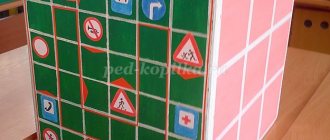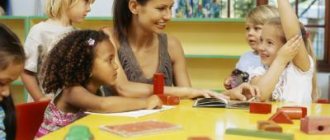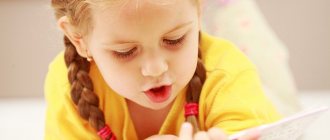Types of finger theater
Sets for theatrical “finger performances” can be very different; when choosing, it is important to start from the goal being pursued (for example, a homemade paper version is suitable for one time), the age and physiological capabilities of the children. Main types:
- Paper/cardboard. The simplest, quickly produced, but short-lived.
- Wood. The figurines are somewhat reminiscent of small nesting dolls; as a standard, they are packaged in themed boxes, which are suitable for use as decorations.
- Knitted. The dolls look “alive”, they are very soft and pleasant to the touch.
- Felt. The most popular option today. Many mothers make figures with their own hands, involving their children in this (they can trace patterns, draw eyes for the characters, etc.). Characters made from felt are bright, durable, and the material itself is comfortable to work with. In addition, its soft surface is believed to be very beneficial for sensory development.
You can often find fabric versions of puppet theaters or figurines felted from wool. At home, together with your children, you can create characters from plasticine, dough, or any other elastic mass - creativity together with your parents brings you very close together. As an option, you can completely remove the caps from children’s toothbrushes, which are often made in the shape of animal heads, and make them the heroes of your improvised theater. No one has canceled fantasy!
From puppet theater in kindergarten to understanding oneself in the world around us
Bibliographic description:
Chekanova, O. L. From puppet theater in kindergarten to knowing oneself in the world around us / O. L. Chekanova.
— Text: direct // Theory and practice of education in the modern world: materials of the I International. scientific conf. (St. Petersburg, February 2012). - T. 1. - St. Petersburg: Renome, 2012. - P. 136-137. — URL: https://moluch.ru/conf/ped/archive/21/1514/ (date of access: 10.10.2020). Puppet theater is the most common form of organizing children's leisure in kindergarten. Puppet shows enjoy the well-deserved love of children and bring great pleasure to the organizers of the productions. The doll itself is very close to children’s perception, because they have been familiar with this toy since early childhood, and therefore perceive it as a close friend. And if this hitherto silent friend unexpectedly comes to life before their eyes, tells stories, sings, laughs and cries - this spectacle turns into a real holiday for them.
However, puppet theater cannot be considered only as entertainment. Its educational and cognitive significance is very important. During the preschool period, the child begins to develop an attitude towards the environment, character, and interests. It is at this age that it is very useful to show children examples of friendship, kindness, truthfulness, and hard work.
Puppet theater is a synthetic art; it influences young spectators with a whole range of artistic means. When showing puppet theater performances, both the artistic word and a visual image - a doll, and picturesque and decorative design, and music - a song, musical accompaniment are used. The skillful use of puppet theater provides great assistance in the daily work of a kindergarten in the mental, moral, and aesthetic education of preschoolers.
The role of puppet theater in the development of a preschool child cannot be overestimated. First of all, a doll helps to establish contact with a child if he is “enslaved,” emotionally “stressed,” or afraid of strangers. A small doll causes less fear and apprehension, and a child, especially a younger one, makes contact with it faster than with an adult. Children who avoid touching are more likely to give a hand and say hello to a doll than to a teacher. By actively interacting with the doll, the child gradually becomes more open and courageous in direct contacts with the outside world, with people. This allows a preschool child to most painlessly go through the period of adaptation to school, new teachers, curriculum, and often to a new children's team.
Familiarization with playing dolls begins at an early age. Putting a doll on his hand - a kitten, a dog, a parsley, the adult sings (melodic sounds attract the baby's attention) a nursery rhyme, a song, a joke, imitates the voices of different animals, evokes a positive emotional reaction in the child, which in turn contributes to the early formation of aesthetic taste in the child, emotional creative needs.
In younger groups, poems, fairy tales, and songs familiar to children are acted out using a table theater. The fairy tale "Turnip", for example, is illustrated using plane dolls. And with the cheerful Petrushka, who is not even hiding behind a screen, the children willingly shake hands and answer his questions.
With children of the third and fourth year of life, they act out the simplest plots of familiar fairy tales, using elements of costumes and hats with silhouettes of characters. The children willingly join in the dramatization of the fairy tale using a flannelgraph, tabletop and finger theater.
Children of the fifth and sixth year of life, as a rule, already know and love puppet theater and participate with great desire in performances. The teacher is faced with the task of encouraging preschoolers to engage in independent theatrical games and to dramatize familiar literary works. Children of this age can already be taught to drive dolls - parsleys and puppets.
By mediating interaction with other people with dolls, timid children begin to understand the process of communicating with peers. By playing the roles of characters with different personalities, children “try on” different models of social behavior. By playing the role of a Wolf or a Bear, a child can express aggression, by playing the role of a Bunny - caution, by playing the role of a Cockerel - determination and courage. This experience allows the child to subsequently show tolerance, perseverance, and kindness in various life situations.
For a child, a puppet theater character is, first of all, a toy. The child sees how performances are performed with the help of dolls and begins to understand that they were created in order to “retell” the content of the fairy tale. Around middle preschool age, the child himself, without the help of dolls, tries to repeat and act out a familiar fairy tale. Active children always enjoy playing roles: putting on costumes, speaking and acting. But for many children, getting on stage is a serious test. It’s often the first time a child dares to speak words from the stage on behalf of a doll. He psychologically hides behind the doll.
In the hands of an adult, a doll is an assistant in solving many pedagogical problems. With the help of a doll, you can create playful motivation for the productive activities of children, give an adequate assessment on behalf of the doll of the product of the child’s activity without the risk of causing his resentment or resistance. This use of characters is most effective when working with children of middle and primary preschool age.
Both adults and children can participate in the puppet show. Such activities enrich children with new impressions, knowledge and skills, develop interest in literature, music, theatrical art, and form aesthetic taste. This is a great opportunity for teachers to carry out various educational, educational, and moral tasks not in an edifying way, but directly, unnoticeably for children, who, as a rule, are captivated by theatrical performances.
Music in puppet shows sounds during the plot, when the characters sing, dance or simply listen to the playing of the violin, piano, harmonica, pipe, etc. Music is introduced to create a certain mood, as a musical setting. However, in a puppet show it is not always of an auxiliary nature. Music often plays a very important role. How long will the attention of a preschool child last if he sits motionless on a chair during a theatrical performance? No more than 10 minutes. What if he takes an active part in the performance, for example, performing as a spectator some piece of music that is especially important for the successful continuation of the performance? This number doubles (sometimes triples)! At the same time, children’s emotional responsiveness, choral singing and children’s performance skills are formed (it’s one thing to sing for the audience, and quite another for the artists themselves!).
The musical repertoire for such performances is prepared with the children in advance during music classes, and the children do not necessarily know where they will use it. This will help maintain the moment of surprise.
The saturation of the performances with emotional and entertaining moments also increases the interest of children. The collective empathy of children forms in them the rudiments of social feelings and relationships.
Performances involving a puppet theater will occupy a certain place in the kindergarten system, provided:
— the presence and development of children’s ideas and interest in various types of theater;
— children mastering the rules and techniques of theatrical activities;
- a serious, sincere, emotionally positive attitude of the teacher towards children’s theater games.
Staging a puppet show with the participation of children is a very labor-intensive task, requiring great emotional investment and creative energy of both the directors and the actors themselves - the children. It is very important to take into account several psychological factors. The process of identifying, detecting the emotions of some children, when it occurs in the presence of the whole group, is necessary not only for the teacher, who uses it as a condition for changing the inappropriate position of the child; This process helps preschoolers understand each other, focus on the strengths and weaknesses of their peers’ character, and understand their experiences. An atmosphere of deep mutual understanding is a fertile ground for eliminating unethical, selfish tendencies in children, cultivating responsiveness, sensitivity to good and intransigence to evil. The means of influencing children’s feelings are: purposeful interaction with morally contradictory characters, the sincere, emotionally expressed attitude of the teacher himself to all moments of a fairy tale or role-playing game, and, finally, the active position of sensitive, responsive children, of whom there are always many in the group.
At first, it is very difficult for a teacher to organize such performances; the ability to quickly and creatively respond to the emotional responses of both actors and spectators, to clearly navigate difficult moments and to direct the entire performance absolutely imperceptibly does not immediately develop. But when this skill comes, working on staging the play gives great pleasure not only to the children, but also to the adults participating in it.
Key terms
(automatically generated)
: puppet theater, child, kindergarten, doll, puppet show, doll face, music, teacher, puppet help, aesthetic taste.
Staging puppet shows. Observations
- As it turned out, having the text of the roles in this form, when each character has his words in bold, it is possible to stage any performance with a script unknown in advance without preparation. This is much more convenient than the option where the author is indicated at the beginning of each replica. Everyone did a great job in their roles, even though they were seeing the text for the first time. They played like real actors and without a single rehearsal.
- As it turned out, the puppeteers held the puppets a little low. The screen for the puppet theater was quite high, the children sat on the ottoman - low, sometimes they even stood up to properly see what was happening. That is, the hand with the doll needs to be stuck out higher. I think there will be nothing terrible if the hand is slightly visible, it will be much better than children seeing only the doll’s head.
- Riddles that rhyme with wrong answers were a bit challenging for little ones. They are suitable for older children. It’s good that the characters repeated each such riddle according to the script several times, and the grandmother actively helped the kids.
- When I wrote the script for the puppet show, it seemed to me that it was very long. But in the end it turned out that it was not. If you stage such a play for older children, you can lengthen the script by one and a half times. The length was just right for our audience.
- There is no need to make decorations at all. There were a lot of people behind the screen, everyone was crawling on their knees. It was very difficult for me to move the scenery properly. In the end, the house, which was made at an angle, fell apart, people started fixing it and almost missed their “exit.”
- But overall, in my opinion, both the audience and the actors liked the performance. Adults sometimes have fun playing too.
Kosyakova Tatyana






